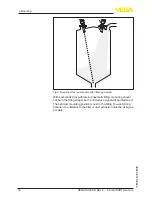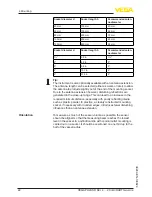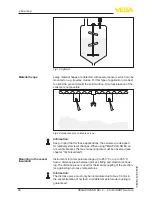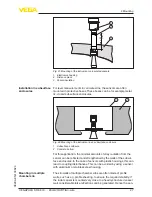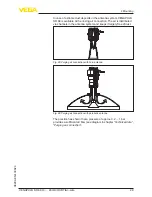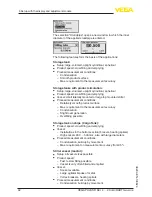
30
5 Connecting to power supply
VEGAPULS SR 68 • 4 … 20 mA/HART two-wire
38294-EN-130624
5 Connecting to power supply
5.1 Preparing the connection
Always keep in mind the following safety instructions:
•
Connect only in the complete absence of line voltage
•
If overvoltage surges are expected, overvoltage arresters should
be installed
Power supply and current signal are carried on the same two-wire
cable. The operating voltage can differ depending on the instrument
version.
The data for power supply are specified in chapter "
Technical data
".
Provide a reliable separation between the supply circuit and the
mains circuits according to DIN EN 61140 VDE 0140-1.
Keep in mind the following additional factors that influence the operat-
ing voltage:
•
Lower output voltage of the power supply unit under nominal load
(e.g. with a sensor current of 20.5 mA or 22 mA in case of fault
message)
•
Influence of additional instruments in the circuit (see load values in
chapter "
Technical data
")
The instrument is connected with standard two-wire cable without
screen. If electromagnetic interference is expected which is above the
test values of EN 61326-1 for industrial areas, screened cable should
be used.
For instruments with housing and cable gland, use cable with round
cross-section. A cable outer diameter of 5 … 9 mm (0.2 … 0.35 in)
ensures the seal effect of the cable gland. If you are using cable with
a different diameter, exchange the seal or use a suitable cable gland.
We generally recommend the use of screened cable for HART multi-
drop mode.
With plastic housing, the NPT cable gland or the Conduit steel tube
must be screwed without grease into the threaded insert.
Max. torque for all housings see chapter "
Technical data
".
If screened cable is required, connect the cable screen on both ends
to ground potential. In the sensor, the screen must be connected
directly to the internal ground terminal. The ground terminal on the
outside of the housing must be connected to the potential equalisa-
tion (low impedance).
If potential equalisation currents are expected, the connection on the
processing side must be made via a ceramic capacitor (e. g. 1 nF,
1500 V). The low-frequency potential equalisation currents are thus
suppressed, but the protective effect against high frequency interfer-
ence signals remains.
Safety instructions
Voltage supply
Connection cable
Cable gland ½ NPT
Cable screening and
grounding



